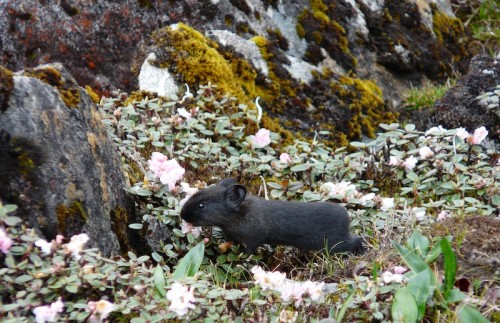A rare mammal sighted by WWF-India’s Survey Team in Arunachal Pradesh
There are still many areas in our world that are unexplored, their secrets hidden often due to their inaccessibility. Many high altitude areas in the north-east Indian state of Arunachal
There are still many areas in our world that are unexplored, their secrets hidden often due to their inaccessibility.
Many high altitude areas in the north-east Indian state of Arunachal Pradesh fall into this category. WWF-India has been working in the western part of Arunachal Pradesh since 2002 with the local communities and government agencies for conservation of biodiversity. WWF-India, jointly with the local villagers, initiated field surveys across Tawang and West Kameng districts of western Arunachal Pradesh. The present survey was conducted as part of the initiative to document the biodiversity of the Thembang Bapu Community Conserved Area (CCA).
The Sighting
During the survey, near Potok area at an altitude of 4300m within the Thembang Bapu CCA, WWF-India’s team came across a rare mammal-the black pika (Ochotona nigritia), hitherto unreported from India. It was found in the rocky burrows of a shrubland habitat with abundant Rhododendron on which it was observed feeding.
Video of black pika recorded during the sighting
Click here if you are unable to view the video.
The black pika, closely related to rabbits and hares, is a small mammal with rounded ears, short limbs, and black fur. It was earlier discovered in Pianma in the Yunnan province of China in 2000.
The pikas or mouse hares are Himalayan dwelling lagomorphs (meaning hare-shaped). India has seven pika species with the black pika slated to perhaps become the eighth. The new species can be distinguished from all other pika species found in India from its characteristic overall black coat colour.
Like many of the smaller high altitude dwelling mammals pikas are considered “Allogenic” engineers i.e. the burrows which they construct to live are used by other species such as birds, reptiles and other smaller mammals. In addition, pikas play a key role as prey to various high altitude predators like birds of prey and small and large carnivores.
Aishwarya Maheshwari, Senior Project Officer, WWF-India adds, “This pika resembles the one discovered in China but it urgently needs genetic confirmation to know whether this newly reported pika is the same or a new subspecies.”
The survey team consisted of Aishwarya Maheshwari, Kripaljyoti Mazumdar and Pema Wange of WWF-India.
The Landscape
The Western Arunachal Landscape (WAL) covers nearly 7000 sq. km in the West Kameng and Tawang districts of Arunachal Pradesh. More than 30 mammals are reported from this area including threatened species like the snow leopard and red panda. WWF-India is working with the villagers of Tawang and West Kameng districts in Western Arunachal for the conservation of forests and wildlife. Encouraged by WWF-India, the village panchayats have adopted resolutions and issued notifications declaring parts of the forest area under their ownership as Community Conserved Area (CCA). The communities have demarcated two such CCAs – Thembang Bapu CCA and Pangchen Lumpo Muchat CCA.
The Chief Wildlife Warden of Arunachal Pradesh, Mr. J.L. Singh, IFS, said, “These areas are quite unexplored and I hope these surveys by WWF-India will increase our knowledge about the wildlife found in such high altitude areas.”
Pijush Dutta, Senior Landscape Coordinator, WAL Programme Office, WWF-India concludes, “Though the terrain is difficult, we are making new discoveries whenever we go out for exploration. This is just the tip of the iceberg, as we believe many more discoveries will follow.”
Photos of black pika from the sighting
Click here if you are unable to watch the photo slideshow.
This story made me
- 97
- 121
- 89
- 167











